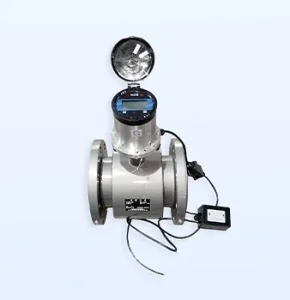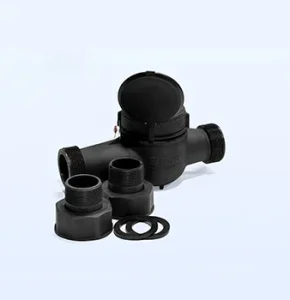اختيار مقياس تدفق المياه المثالي يعني التفكير في الإعداد الخاص بك، والمياه التي تقوم بقياسها، وأين يذهب المقياس. الميكانيكية مثل تشينشوعدادات الدوار ، هي صديقة للميزانية لتتبع المياه المنزلية المستمرة. العدادات الكهرومغناطيسية رائعة للمصانع أو المياه الفوضوية ، مما يعطي قراءات على الفور مع أي صيانة بالكاد. يحافظ النحاس أو الفولاذ المقاوم للصدأ على صلابتها ، وتتيح لك التكنولوجيا الذكية مثل Modbus أو LoRaWAN تتبع الأشياء في الوقت الحقيقي. Chenshuo حصلت على ظهرك مع خيارات مخصصة ودعم قوي.

اختيار مقياس المياه يعني التفكير بجد في أهدافك، والسائل الذي تقوم بقياسه، وأين سيتم تركيبه. هذه الأشياء تؤثر على مدى دقة العداد ، وما إذا كان يناسب نظامك ، ومدة استمراره.
أولا، حدد ما تحتاج إلى مقياس المياه. هل هو للفواتير في المنازل، أو تتبع المياه في المصانع، أو إدارة الري؟ على سبيل المثال ، تحتاج المصانع أو محطات الطاقة إلى عدادات دقيقة للغاية مع القليل من الصيانة. ولكن بالنسبة للمنازل أو المزارع ، قد ترغب في شيء بسيط ورخيص.
نوع المياه مهم جداً. هل هو موصل؟ حار أم بارد؟ تحت ضغط؟ هل لديك قطع من القذارة أو المواد الصلبة؟ يعمل مقاييس المياه الكهرومغناطيسية بشكل رائع لمعظم السوائل الموصلة ، مثل المياه أو مياه الصرف الصحي أو الحمأة. إنها مثالية لإعدادات صناعية صعبة. ومع ذلك ، فإن مقاييس المياه الميكانيكية أفضل للمياه النظيفة مع تدفق ثابت.
فكر في المكان الذي سيذهب إليه المقياس. هل هناك مساحة كافية؟ هل الأنابيب أفقية أو عمودية؟ ما هي درجة الحرارة مثل؟ هل يمكنك الوصول إليها لإصلاحها؟ بالنسبة للمياه ذات المواد الصلبة ، غالبا ما تكون الأنابيب العمودية أفضل لتجنب التراكم. تعتمد طريقة تثبيت مقياس المياه على نوعه والماء الذي يقيسه.
تعتمد التكنولوجيا الصحيحة على مدى دقة الحاجة إليها، ومقدار الصيانة التي يمكنك التعامل معها، وما هو شكل المياه.
تستخدم مقاييس المياه الميكانيكية أجزاء متحركة تدور أو تتحرك مع تدفق المياه من خلالها. إنها شائعة في المنازل وأنظمة المدن لأنها بسيطة ولا تكلف الكثير.

عدادات المياه الميكانيكية الدوارة استخدم مكبس دوار أو شفرة لقياس تدفق المياه. إنها رائعة لأنظمة المياه المنزلية حيث يبقى التدفق ثابتا إلى حد ما. تحقق من نماذج مثل مقياس المياه الميكانيكية الدوارة من Chenshuo. تأتي مع أجسام النحاس أو النايلون لمطابقة أنابيب مختلفة.
هذه العدادات سهلة الاستخدام ورخيصة الشراء. قد تحتاج إلى تنظيف أو إعادة معايرة من وقت لآخر لأن الأجزاء المتحركة تتآكل. ولكن مع المواد القاسية مثل النحاس ، فهي تدوم لفترة طويلة في ظروف طبيعية.
تم بناء مقاييس المياه الكهرومغناطيسية لقياسات دقيقة للسوائل الموصلة.
إن عداد المياه الكهرومغناطيسيأو EMF ، يستخدم قانون فاراداي. عندما يتحرك الماء عبر مجال مغناطيسي في أنبوب المقياس ، فإنه يخلق جهد مرتبط بسرعة التدفق. يتحول هذا الجهد إلى إشارة رقمية تظهر كم من الماء يتدفق.
هذه العدادات لا تبطئ التدفق ، مما يوفر الطاقة في الأنابيب الكبيرة. مع عدم وجود أجزاء متحركة في الداخل ، فهي متينة للغاية ، حتى مع الماء الخام أو الطين. تبقى دقيقة على نطاق واسع، مما يجعلها مثالية لمراقبة المصانع أو أنظمة مياه الصرف الصحي.
مقاييس المياه الميكانيكية رخيصة وسهلة الإعداد للوظائف البسيطة. الكهرومغناطيسية تلمع في الأماكن التي تحتاج إلى دقة عالية وصيانة منخفضة. يعتمد اختيارك على ميزانيتك ومقدار الأداء الذي تحتاجه.
للحفاظ على قياس المياه يعمل بشكل جيد مع مرور الوقت ، تحتاج إلى التحقق من بعض المواصفات الرئيسية.
يتم عرض خطأ مقياس المياه كنسبة مئوية. اختر العدادات التي تلبي المعايير العالمية مثل ISO 4064 أو OIML R49. هذا يضمن أنها موثوقة وموثوقة في جميع أنحاء العالم.
في الأنظمة الكبيرة ، فإن فقدان الضغط مهم جداً. يمكن أن تضيع الطاقة. مقاييس المياه الكهرومغناطيسية لديها انخفاض ضغط أقل من الميكانيكية ، والتي تحتوي على أجزاء تمنع التدفق.
نسبة التحول هي معدل التدفق العادي (Q3) مقسوم على الحد الأدنى من معدل التدفق (Q1). نسبة أعلى تعني أن العداد يمكن أن يتعامل مع التدفقات المتغيرة دون فقدان الدقة. هذا هو المفتاح للصناعات التي لديها طلبات صعودية وهبوطية.
اختيار المواد المناسبة يضمن قياس المياه الخاص بك يستمر دون انهيار.
تأكد من أن أجزاء المقياس يمكن أن تتعامل مع درجة الحموضة للماء ودرجة الحرارة (من -25 درجة مئوية إلى 60 درجة مئوية للأجهزة الاستشعارية) أو أي مواد صلبة دون التآكل. هذا يحافظ على استقرار الأداء مع مرور الوقت.
استخدم النحاس للقوة تحت الضغط. اختر الفولاذ المقاوم للصدأ لمقاومة الصدأ. إذهب مع البلاستيك (مثل النايلون) لتخفيف الوزن دون فقدان الاستقرار الكيميائي.
تحتاج الأنظمة الحديثة إلى عدادات المياه التي تعمل مع الإعدادات الرقمية للتتبع في الوقت الحقيقي.
ابحث عن أجهزة قياس مع مخرجات قياسية مثل حلقات التيار 4-20 mA أو Modbus RTU عبر RS485. هذه تسمح للقياس بالاتصال بأنظمة SCADA أو PLCs للأتمتة.
تستخدم بعض مقاييس المياه المتقدمة تقنية لاسلكية مثل LoRaWAN أو منصات السحابة. هذه ممتازة للمواقع البعيدة حيث تحتاج إلى التحقق من الاستخدام من مكان مركزي.
تقع شركة تشنشو في حديقة شياوانزي الصناعية في شاندونغ، وتصنع مقاييس مياه دقيقة للمدن والمزارع ومحطات الطاقة والمصانع. وتشمل مجموعة أجهزة قياس المياه الميكانيكية الدوارة من النحاس أو النايلون ونماذج كهرومغناطيسية ذكية للاستخدام الصناعي ، كلها مدعومة بدعم من الخبراء.
وتشمل هذه نماذج LXS-15 إلى LXS-65 من النحاس أو النايلون. إنها مثالية للقياس المنزلي حيث تحتاج إلى تتبع موثوق به وصديق للميزانية.
حجمها الصغير يجعلها سهلة التثبيت ، حتى في الأماكن الضيقة. إنها تعطي قراءات حجم ثابتة تحت الضغوط العادية.
مع المواد المقاومة للصدأ مثل النحاس ، تعمل هذه العدادات بشكل جيد لسنوات مع القليل من الصيانة ، مما يجعلها شراء ذكي للإعدادات الكبيرة.
هذه المقاييس تعطي قياسات دقيقة للأنابيب من صغيرة إلى عرض 3 أمتار.
فهي تقيس سرعة تدفق المياه وحجمها بدقة، حتى في ظروف صعبة مثل أنظمة تبريد محطات الطاقة أو محطات مياه الصرف الصحي.
مع نسب التبديل تصل إلى 50: 1 ، تتعامل هذه العدادات مع التغييرات الموسمية أو عمليات الدفعات دون الحاجة إلى تعديلات مستمرة.
اختر نموذجاً بناءً على ما تستخدمه:
إذهب مع عدادات المياه الميكانيكية الدوارة لتتبع استخدام المياه بسهولة وبأسعار معقولة.
بالنسبة للحقول التي فيها مياه قذرة أو تغير الطقس ، تعمل مقاييس المياه الكهرومغناطيسية بشكل رائع. تصميمهم غير المسدود يتعامل مع تدفقات مليئة بالرواسب.
بالنسبة لمهام مثل الجرعات الكيميائية، تتزاوج مقاييس المياه الكهرومغناطيسية مع الأنظمة الآلية لتعزيز الدقة وتقليل الخطأ البشري.
Chenshuo تقدم أكثر من مجرد عدادات المياه. تقدم الدعم الكامل من البداية إلى النهاية.
يعمل فريقهم معك لاختيار إعداد العداد المناسب لموقعك وقواعدك.
خطط الصيانة المنتظمة تحافظ على دقة العدادات وتقليل وقت التوقف مع عمليات التفتيش الاستباقية.
هل تريد جعل نظامك أكثر كفاءة؟ اتصال تشنشو في ivy@sdchenshuo.cn أو اتصل بـ 86 15562945993 للحصول على نصائح مخصصة لاختيار المياه المثاليةر.
س: ما الفرق بين القيم Q3 / Q1 عند مقارنة مقاييس المياه؟
ج: نسبة التدفق هي معدل التدفق العادي (Q3) مقسوم على الحد الأدنى من معدل التدفق (Q1). نسبة أعلى تعني دقة أفضل على التدفقات المتغيرة.
س: هل يمكنني استخدام مقياس المياه الكهرومغناطيسية للسوائل ذات الموصلات المنخفض؟
ج: لا ، يحتاجون إلى سوائل ذات موصلات فوق 5 μS / سم للعمل بشكل صحيح.
س: كيف أتجنب الأخطاء الناجمة عن الفقاعات في الماء؟
ج: يمكن للفقاعات أن تفسد القراءات. قم بتثبيت مقياس الصمامات لتجنب تغييرات الضغط التي تسبب الفقاعات.